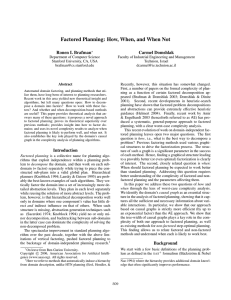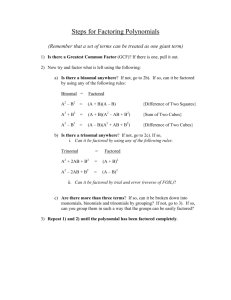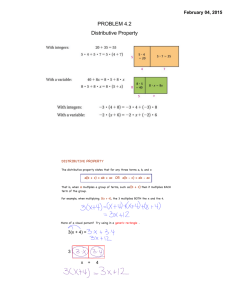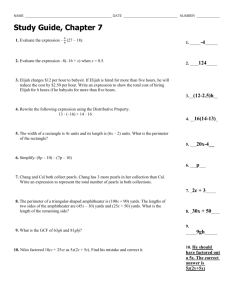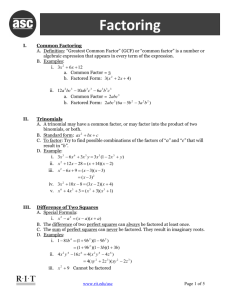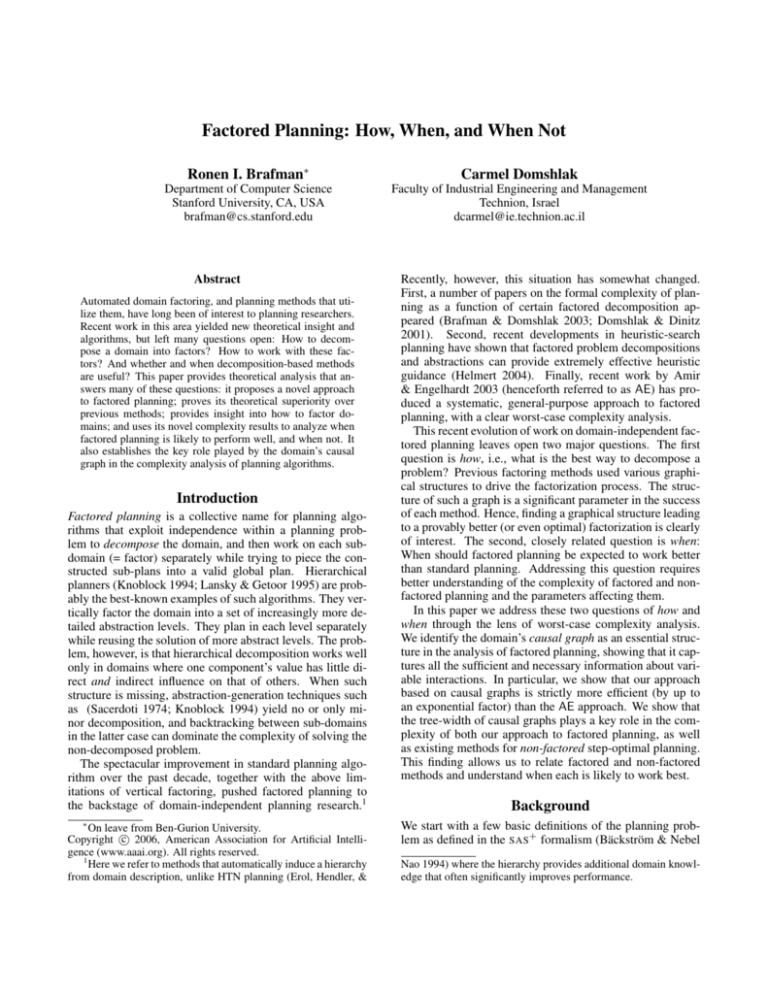
Factored Planning: How, When, and When Not
Ronen I. Brafman∗
Carmel Domshlak
Department of Computer Science
Stanford University, CA, USA
brafman@cs.stanford.edu
Faculty of Industrial Engineering and Management
Technion, Israel
dcarmel@ie.technion.ac.il
Abstract
Automated domain factoring, and planning methods that utilize them, have long been of interest to planning researchers.
Recent work in this area yielded new theoretical insight and
algorithms, but left many questions open: How to decompose a domain into factors? How to work with these factors? And whether and when decomposition-based methods
are useful? This paper provides theoretical analysis that answers many of these questions: it proposes a novel approach
to factored planning; proves its theoretical superiority over
previous methods; provides insight into how to factor domains; and uses its novel complexity results to analyze when
factored planning is likely to perform well, and when not. It
also establishes the key role played by the domain’s causal
graph in the complexity analysis of planning algorithms.
Introduction
Factored planning is a collective name for planning algorithms that exploit independence within a planning problem to decompose the domain, and then work on each subdomain (= factor) separately while trying to piece the constructed sub-plans into a valid global plan. Hierarchical
planners (Knoblock 1994; Lansky & Getoor 1995) are probably the best-known examples of such algorithms. They vertically factor the domain into a set of increasingly more detailed abstraction levels. They plan in each level separately
while reusing the solution of more abstract levels. The problem, however, is that hierarchical decomposition works well
only in domains where one component’s value has little direct and indirect influence on that of others. When such
structure is missing, abstraction-generation techniques such
as (Sacerdoti 1974; Knoblock 1994) yield no or only minor decomposition, and backtracking between sub-domains
in the latter case can dominate the complexity of solving the
non-decomposed problem.
The spectacular improvement in standard planning algorithm over the past decade, together with the above limitations of vertical factoring, pushed factored planning to
the backstage of domain-independent planning research.1
∗
On leave from Ben-Gurion University.
c 2006, American Association for Artificial IntelliCopyright gence (www.aaai.org). All rights reserved.
1
Here we refer to methods that automatically induce a hierarchy
from domain description, unlike HTN planning (Erol, Hendler, &
Recently, however, this situation has somewhat changed.
First, a number of papers on the formal complexity of planning as a function of certain factored decomposition appeared (Brafman & Domshlak 2003; Domshlak & Dinitz
2001). Second, recent developments in heuristic-search
planning have shown that factored problem decompositions
and abstractions can provide extremely effective heuristic
guidance (Helmert 2004). Finally, recent work by Amir
& Engelhardt 2003 (henceforth referred to as AE) has produced a systematic, general-purpose approach to factored
planning, with a clear worst-case complexity analysis.
This recent evolution of work on domain-independent factored planning leaves open two major questions. The first
question is how, i.e., what is the best way to decompose a
problem? Previous factoring methods used various graphical structures to drive the factorization process. The structure of such a graph is a significant parameter in the success
of each method. Hence, finding a graphical structure leading
to a provably better (or even optimal) factorization is clearly
of interest. The second, closely related question is when:
When should factored planning be expected to work better
than standard planning. Addressing this question requires
better understanding of the complexity of factored and nonfactored planning and the parameters affecting them.
In this paper we address these two questions of how and
when through the lens of worst-case complexity analysis.
We identify the domain’s causal graph as an essential structure in the analysis of factored planning, showing that it captures all the sufficient and necessary information about variable interactions. In particular, we show that our approach
based on causal graphs is strictly more efficient (by up to
an exponential factor) than the AE approach. We show that
the tree-width of causal graphs plays a key role in the complexity of both our approach to factored planning, as well
as existing methods for non-factored step-optimal planning.
This finding allows us to relate factored and non-factored
methods and understand when each is likely to work best.
Background
We start with a few basic definitions of the planning problem as defined in the SAS+ formalism (Bäckström & Nebel
Nao 1994) where the hierarchy provides additional domain knowledge that often significantly improves performance.
1995) followed by the definition of the causal graph. The
SAS + formalism models domains using multi-valued state
variables. It distinguishes between pre-conditions and prevail conditions of an action. The former are required values
of variables that are affected by the action. The latter are required values of variables that are not affected by the action.
The post-conditions of an action describe the new values its
precondition variables. For example, having a visa is a prevail condition for applying the action Enter-USA, while having a valid ticket is a precondition of the action Fly-To-USA,
as its value changes from true to false following the action’s
execution. An action is applicable if and only if both its preand prevail conditions are satisfied.
Definition 1 A SAS+ problem instance is given by a
quadruple Π = hV, A, I, Gi, where:
• V = {v1 , . . . , vn } is a set of state variables with finite
domains dom(vi ). The domain dom(vi ) of the variable vi
induces an extended domain dom+ (vi ) = dom(vi )∪{u},
where u denotes the value: unspecified.
• I is a fully specified initial state, that is, I ∈ ×dom(vi ).
By I[i] we denote the value of vi in I.
• G specifies a set of alternative goal states. Adopting the
standard practice in the planning research, we assume
that such a set is specified by a partial assignment on V ,
that is, G ∈ ×dom+ (vi ). By G[i] we denote the value
provided by G to vi (with, possibly, G[i] = u.)
• A = {a1 , . . . , am } is a finite set of actions. Each
action ai is a tuple hpre(ai ), post(ai ), prv(ai )i, where
pre(ai ), post(ai ), prv(ai ) ⊆ ×dom+ (vi ) denote the pre-,
post-, and prevail conditions of a, respectively. In what
follows, by pre(a)[i], post(a)[i], and prv(a)[i] we denote
the corresponding values of vi .
The factorization of planning problems we propose here
is based on the well-known causal graph structure (Bacchus
& Yang 1994; Knoblock 1994; Brafman & Domshlak 2003;
Domshlak & Dinitz 2001; Helmert 2004; Williams & Nayak
1997).
Definition 2 Given a planning problem Π = hV, A, I, Gi,
the causal graph CGΠ of Π is a mixed (directed/undirected)
−→
graph over the nodes V . A directed edge (−
v−
i , vj ) appears
in CGΠ if (and only if) some action in A that changes the
value of vj has a prevail condition involving some value of
vi . An undirected edge (vi , vj ) appears in CGΠ if (and only
if) some action in A changes the values of vi and vj simultaneously.
Informally, the immediate predecessors of v in CGΠ are
all those variables that directly affect our ability to change
the value of v. It is worth noting that nothing in Definition 2
prevents us from having for some pair of variables vi , vj ∈
−→
−−−→
V in CGΠ both (−
v−
i , vj ), and (vj , vi ), and (vi , vj ). In any
case, it is evident that constructing the causal graph CGΠ of
any given SAS+ planning problem Π is straightforward.
Example 1 Suppose we have two packages, A and B, a
rocket, and two locations, E and M . Packages can be either in a location or in the rocket, and the rocket requires
89:;
?>=<
f
89:;
?>=<
r D
zz DDDD
z
z
D!
}zz
89:;
?>=<
89:;
?>=<
a
b
Figure 1: Causal graph for Example 1.
fuel to fly. The actions correspond to loading and unloading
the packages, flying the rocket, and fueling the rocket. Flying the rocket consumes the fuel, but it can be fueled in any
location. We model this problem in the SAS+ formalism as
follows. The variables are r, a, b, f ; r denotes the position
of the rocket and its domain is at-E, at-M. a and b denote
positions of the packages A and B and their domains are:
at-E, at-M, at-rocket. f denotes whether or not the rocket
has fuel with values full and empty. For x 6= y ∈ {e,m},
the actions are fly-x-y, load-x-y, unload-x-y, and fuel. The
fly-x-y actions have two precondition – f =full and r=at-x.
Their post-conditions are f =empty and r=at-y. The loadx-y actions have one precondition – x=at-y – and one prevail condition – r=at-y. The single post-condition is x=atrocket. Finally, the action fuel has one pre-condition and
one post-condition: empty and full respectively. The causal
graph for this problem is shown in Figure 1.
Sequence-Based CSP Planning
The central questions for any factored planning approach are
how to decompose the problem and how to piece together
solutions from different sub-domains. Our initial answer to
the first question, which later we generalize, is very simple:
factor = variable. We can now focus on the questions of how
to combine a set of given local plans for different factors, and
then, how to generate these local plans. The causal graph
plays a key role in the algorithm we propose. Its tree-width
plays an equally important role in the complexity analysis of
the algorithm.
Locally-Optimal Factored Planning
Let Ai ⊆ A denote the set of all actions affecting vi ∈
V . Suppose that, for every vi , we are given a set of prescheduled action sequences SP lan(vi ) where each ρi ∈
SP lan(vi ) is a finite sequence of pairs (a, t) with a ∈ Ai ,
and t ∈ Z+ is the time point at which a is to be performed.
We now ask ourselves how we might construct plans using
these n sets of action sequences SP lan(vi ). A key observation is that this particular problem can be solved by compiling it into a binary CSP (denoted SeqCSP) over n variables
X1 , . . . , Xn where:
1. The domain of Xi is exactly SP lan(vi ), and
2. The constraints of SeqCSP bijectively correspond to the
edges of the causal graph CGΠ .
Informally, the constraint corresponding to a directed edge
−→
(−
v−
i , vj ) ∈ CGΠ ensures that the action sequence selected
for vi provides all the prevail conditions required by the actions of the sequence selected for vj , and that the timing of
procedure LID
d := 1
loop
for i := 1 . . . n do
Dom(Xi ) := all sub-plans for vi of length up to d,
over all schedules across nd time points.
Construct SeqCSPΠ (d) over X1 , . . . , Xn .
if ( solve-csp(SeqCSPΠ (d)) ) then
Reconstruct a plan ρ from the solution of SeqCSPΠ (d).
return ρ
else
d := d + 1
endloop
Figure 2: Factored planning via local iterative deepening.
this provision is correct. The constraint corresponding to an
undirected edge (vi , vj ) ∈ CGΠ ensures that the restrictions
of the sequences selected for vi and vj to Ai ∩ Aj are identical. This causal-graph based problem reformulation allows
us to formalize the worst-case complexity of solving our
“sequences combination” problem in a structure-informed
manner. Since each constraint of SeqCSP can be verified in polynomial time, from a classical result on tractable
CSPs (Dechter 2003) we have that the time complexity of
the “sub-plans combination” problem is O(nσ w+1 ), where
w is the tree-width of the undirected graph underlying CGΠ ,
and σ = maxi {|SP lan(vi )|}.
While in itself our “sequences combination” problem is
not of general interest, the distance between its CSP formulation, and that of general planning problems is not large.
Specifically, given a planning problem Π = hV, A, I, Gi,
one can solve it using the LID (short for local iterative deepening) procedure depicted in Figure 2. LID searches for a
plan by performing local iterative deepening on the maximal
number of changes that a plan might induce on a single state
variable. Given such an upper bound d ≥ 1, LID formulates a constraint satisfaction problem SeqCSPΠ (d) where,
for 1 ≤ i ≤ n, SP lan(vi ) contains all (consistent with I
and G) sequences of length at most d of actions affecting vi .
Each such sequence is considered with respect to all possible time schedules of its actions. Since each state variable
in iteration d is allowed to change its value up to d times,
it is sufficient to consider a time horizon of nd. If, at some
iteration d, SeqCSPΠ (d) is solvable, a valid plan (containing
no idle time points) can be easily extracted from the corresponding solution of SeqCSPΠ (d).
Theorem 1 LID is a sound and complete planning algorithm. Moreover, if LID terminates with a plan ρ at iteration
d, then, for any other plan ρ0 for the considered problem instance, there exists a state variable that changes its value on
ρ0 at least d times.
The CSP encoding used in LID may seem a bit crude, but
it is simple to understand, and all the essential ideas and
formal results of this work already fall out from it. In the
technical report we describe an equivalent, yet technically
more involved, encoding in the spirit of standard planningas-CSP encodings. For the next result we introduce the following notation: Let P lan(Π) be the (possibly infinite) set
of all plans for Π. For each plan ρ ∈ P lan(Π), and each
1 ≤ i ≤ n, let ρi denote the subset of all actions in ρ affecting variable vi . Finally, let GCG denote the undirected
graph underlying causal graph CGΠ .
Theorem 2 Given a planning problem Π, it can be solved
using LID in time
O(n(nδa)wδ+δ )
(1)
where a = maxi {|Ai |}, w is the tree-width of GCG , and δ
is the local depth of Π defined as:
δ=
min
max {|ρi |}
ρ∈P lan(Π) 1≤i≤n
(2)
Theorem 2 expresses the complexity of LID in terms of
two parameters. The tree width of the domain’s causal graph
measures the level of interaction between the domain variables. The parameter δ is problem-instance dependent and it
expresses the minmax amount of work required on a single
variable. In particular, we note that Theorem 2 establishes a
new tractable class of planning problems, because for problems with both w and δ bounded by some constants, Eq. 1
trivially reduces to a polynomial.
Generalized Factoring
So far, we assumed that factor = variable, yet it is not clear
that this factorization leads to the best possible worst-case
performance. Here we take a closer look at this question
by drawing on our previous analysis to understand possible
effects of using a different factoring.
Two parameters affect the worst-case complexity of factored planning: tree-width and minmax number of changes
per factor (local depth, for factor=variable.) Thus, we need
to understand the effect of alternative factorizations on these
parameters. Consider variables v1 , . . . , vk that change their
value c1 , . . . , ck times in a locally optimal plan when single
variable factors are used. If we combine these variables into
a single factor, this new factor will change its value at most
Pk
i=1 ci times in any locally optimal (for the new factorization) plan. In general, it is not hard to verify that the minmax
number of changes per factor under factorization with maximal factor size k could be as large as kδ.
While this seems like a big loss, observe that it can be offset by a reduction in the tree-width of the constraint graph.
Indeed, it is well known that for each CSP whose primal
graph has tree-width w, there is a tree-decomposition with
maximal node size w + 1. Such a tree-decomposition defines an equivalent CSP whose variables (our new factors)
are cross-products of the original variables, and whose constraint graph forms a tree2 , that is, has tree-width of 1. We
also already know that df , the minmax number of value
changes per new factor, is upper bounded by (w+1)δ. However, observe that it can also be much better. For any treedecomposition, we know that df is bounded by the maximal
sum of value changes of original variables in any new factor.
If so, then unless all the variables clustered together have to
2
Though constructing an optimal tree-decomposition (i.e., one
with maximal node size w + 1) is NP-hard (Arnborg, Cornell, &
Proskurowski 1987), there are numerous effective, fast approximation and heuristic algorithms for this problem.
change δ times each, df would be less than (w + 1)δ, and
possibly much less, down to δ!
Consequently, we can adapt LID to any treedecomposition, and any form of factoring. Instead of
iterating over the maximal number of value changes
of a variable, we iterate over the maximal number of
value changes of a factor, i.e., a node of the given treedecomposition. We refer to this procedure as LID-GF, and
its complexity is described by Theorem 3.
Theorem 3 Given a planning problem Π, the time complexity of solving it using LID-GF on an
optimal treedecomposition of GCG is O n(wa + a)df , where w is the
treewidth of GCG , a = maxi {|Ai |}, and df ≤ (w + 1)δ.
It is now apparent that by moving from the extreme of factor = variable to an optimal tree-decomposition, we cannot
lose, and are most likely to improve our worst-case complexity. The complexity now changes from exponential in
wδ to something that is at least as good as wdavg , where
davg is the maximal (over the factors) average number of
variable changes within the factor. Thus, when constructing
a tree-decomposition, one needs to consider both the cluster
size and its variability, where the value to keep in mind is
the (unknown) sum of value changes of variables in a cluster. The good news is that even if we know nothing about
the domain, Theorems 2 and 3 imply that we cannot lose by
moving to an optimal tree-decomposition.
Perhaps the better news is that we have here a concrete
role for domain knowledge. Suppose we have some idea
about which variables are likely to change a lot and which
variables are likely to change just a little. In that case, we
can impose some constraints on the tree-decomposition, ensuring that certain variables appear together in it. We can do
this by constructing a constrained tree-decomposition, that
is, a tree decomposition in which we a priori require certain
problem variables to be together. This could lead us to tree
decomposition with larger nodes, but with smaller sum-ofvalue-changes, leading to improved performance.
Comparison with AE
Having our generalized LID-GF approach, we now show that
it provides better complexity guarantees than AE, a recently
proposed approach to factored planning with the first clear
complexity analysis (Amir & Engelhardt 2003).
Similarly to LID-GF, AE has a single factoring phase, followed by a sequence of planning phases invoked in an iterative deepening fashion over the upper-bound on the depth
of the local plans. The factoring phase takes a certain graph
induced by the given problem instance, and constructs a tree
decomposition of this graph (named here AEGΠ ) using one
of the off-the-shelf algorithms for close-to-optimal tree decomposition. Given such a tree of planning factors (each factor corresponding to a subset of state variables), each planning phase processes this tree incrementally in a bottom-up
fashion. In processing each sub-domain, AE looks for a local plan of a bounded depth over a certain set of complex
macro actions. The search for local plans is performed using a generic black-box planner.3
Though algorithmically different, both LID-GF and AE
use local iterative deepening to search for plans, and provide similar guarantees on the quality of the resulting plan.
That is, plans returned by both approaches are guaranteed to
be locally optimal at the level of factors of tree decomposition in use. However, the worst-case complexity of these
two approaches is not the same. First, while both approaches
scale linearly in the number of state variables, the worst-case
2
complexity of AE grows exponentially in Θ(wae
δ) where
wae is the tree-width of AEGΠ , while that of LID-GF grows
exponentially in Θ(wδ). Assuming for a moment that the
tree-width of the causal graph and this of AEGΠ are comparable, this already shows that LID-GF is worst-case more
efficient than AE. However, Theorem 4 shows that the actual difference is much larger, and that it can be exponential
in Θ(n).
Theorem 4 Given a planning problem Π, let w be the treewidth of GCG , and wae be the tree-width of AEGΠ . For all
planning problems Π, we have wd ≤ wae , and there are
problems for which we have wd = O(1) and wae = Θ(n).
Such a gap between the time complexity of LID-GF and
AE stems from the structure of the dependencies between
the state variables that these two approaches exploit. While
problem decomposition in LID-GF is based on the causal
graph, AEGΠ is an undirected graph over the nodes V , containing an edge (vi , vj ) iff there is an action a ∈ A that
somehow involves both vi and vj , that is,
(pre(a)[i] 6= u ∨ post(a)[i] 6= u ∨ prv(a)[i] 6= u) ∧
(pre(a)[j] 6= u ∨ post(a)[j] 6= u ∨ prv(a)[j] 6= u)
Given that, it is easy to verify that GCG is a subgraph of
AEGΠ , and thus w ≤ wae . (To prove Theorem 4 we provide
an example of a linear difference between w and wae .)
Factoring and Plan Optimality
Classical planning offers a few notions of plan optimality,
with the most standard being sequential optimality (henceforth, OP), which corresponds to a plan with a minimal number of actions. Step-optimal planning (SOP) is an alternative
that stands for minimizing the number of time steps in which
a plan can be executed under a valid parallelizing of its actions. Depending on the application, SOP can be either of
interest on its own, or considered as a reasonable compromise when OP is beyond reach. We argue that, from this
perspective, the notion of local optimality (LOP) targeted
by factored planners is not any different. In some applications, LOP is of interest on its own, e.g., in the context of
distributed systems. And viewed as an approximation to OP,
LOP and SOP provide similar guarantees, as shown below.
Lemma 1 Given a planning problem Π,
let
mop , msop , mlop denote the number of actions in an
optimal, step-optimal, and locally optimal plan, respectively. We have that msop ≤ n · mop and mlop ≤ n · mop
3
For detailed description of AE, see (Amir & Engelhardt 2003).
(where n is the number of variables in Π), and both these
bounds are tight.
Given the “approximation equivalence” between SOP and
LOP established by Lemma 1, we turn to consider the time
complexity guarantees of standard methods for OP, SOP, and
LOP. To the best of our knowledge, such worst-case time
guarantees for OP are either exponential in the length of the
optimal plan (e.g., state-space forward search using BFS), or
exponential in the problem size (e.g., planning-as-CSP with
a linear encodings (Kautz & Selman 1996)). At this point,
for SOP, all methods with established complexity guarantees are of the second type, that is, worst-case exponential in
the problem size – we will have something to say about this
later. Thus, moving from OP to SOP appears to buy us nothing in terms of formal bounds on the time complexity. The
situation with LOP, however, is different. Theorem 2 shows
that the direct dependence of LID’s complexity on both the
problem size and plan length is polynomial. The exponential
dependence of LID is on two other, deeper problem characteristics, namely the tightness of problem structure (w), and
the amount of local effort required on each problem factor
in order to solve the problem (δ).
Below we take a closer look at the relationship between
the complexity guarantees for LOP, SOP, and OP. In the
course of this comparative analysis, we provide and exploit
some new results on the complexity of SOP. In particular,
these results show that in certain situations SOP can actually provide better upper bounds on time complexity than
OP. Moreover, these results emphasize the importance of the
causal graph in the analysis of planning, as its tree-width
plays an important role in the analysis of SOP, as well.
Complexity of SOP using DK
To make our discussion concrete, we consider a characteristic planning-as-CSP approach to SOP described in (Do &
Kambhampati 2001) (named here DK). While describing
the DK encoding, we ignore the use of graphplan in DK to
obtain reachability information in form of temporal mutexes.
We make this simplification to separate between the core of
the methods and their various possible extensions. The DK
encoding is parameterized by an upper bound, m, on the
step-length of a plan. Given m, the DK encoding includes a
single variable v [k] for every problem variable v and every
time stamp 1 ≤ k ≤ m. The domain of each variable v [k]
is the set of actions that can change the value of v. For any
1 ≤ k ≤ m, the value of all variables v [k] encode the state
of the system at time k. The following (binary) constraints
are imposed:
[1]
• Initial state: If vi = a, then pre(a) ∪ prv(a) ⊆ I.
[m]
• Goals: If vi
= a and G[i] 6= u, then post(a)[i] = G[i].
[k]
[k−1]
• Precondition: If vi
= a and vi
post(a0 )[i] = pre(a)[i].
[k]
[k−1]
= a0 , then
[k]
• Prevail condition: If vi = a, vj
= a0 , vj = a00 ,
0
and prv(a)[j] 6= u, then post(a )[j] = post(a00 )[j] =
prv(a)[j].
ONML
HIJK
HIJK
ONML
HIJK
ONML
f [1] TTT
f [2] TTT
f [3]
TTTjTjjjjj
TTTjTjjjjj
T
T
j
j
j TTTT
j TTTT
jjjj
jjjj
GFED
@ABC
@ABC
GFED
@ABC
GFED
[1]
[2]
r[3]
r
r
JJJ
JJJ
t
t
t
t
t
t
JJ
JJ
ttt
ttt
ttt
@ABC
GFED
@ABC
GFED
@ABC
GFED
[1]
[2]
[3]
a
a
a
@ABC
GFED
b[2]
@ABC
GFED
b[1]
GFED
@ABC
b[3]
(d)
Figure 3: Primal graph GDK of DK-CSPΠ (3) for example.
[k]
[k]
• Simultaneity: If a ∈ Ai ∩ Aj , then vi = a iff vj = a.
The DK encoding, when used in conjunction with iterative deepening on the plan-length bound m is guaranteed to
yield a step-optimal plan (Do & Kambhampati 2001). Now,
(3)
Figure 3 depicts the primal graph GDK of DK-CSPΠ (3) for
our running example. Observe that constraints between variables at adjacent time points in DK-CSPΠ (m) (i.e., variables
[k]
[k+1]
of the form vj and vi
) involve only neighboring vari(m)
ables within the causal graph. Indeed, GDK corresponds to
connected layers of (undirected) causal graphs GCG . Thus,
(m)
we would expect the tree-width of GDK to be closely related
to the tree-width w of GCG , and this is indeed the case.
Lemma 2 Let Π be a planning problem, and let w be the
tree-width of GCG . For any m ≥ 1, the tree-width wm of
(m)
GDK is bounded by wm ≤ min {wm, n}. This upper bound
is tight for m > n, that is, we have wm = n.
Using Lemma 2, we can immediately provide a structureaware complexity bound on the “global-length” iterative
deepening approach to CSP-based planning.
Theorem 5 Let Π be a planning problem, w be the
tree-width of GCG , and m be the minimal concurrent
length of a plan for Π.
Then, Π can be solved
in time O(min {nm · an+1 , nm · awm+1 }), where a =
maxi {|Ai |}.
LID/LOP vs. DK/SOP
With these results, we can compare the relative strengths and
weaknesses of DK and LID with respect to their time complexity guarantees. We believe that the overall insight holds
for other SOP methods as well. We distinguish between a
few cases based on the tightness of the causal graph (w),
and the step-length of optimal plans (m).
(1) w = Θ(n). This is the case of very dense causal graphs,
indicating strong interactions between variables. This case
is a-priori unlikely to be favorable for a factored approach,
and Theorems 2 and 5 concur.
(2) w = O(1). In that case, LID’s complexity is exponential
in δ, while DK is exponential in min{m, n}. Since δ ≤ m,
LID dominates whenever δ < n. For example, when m =
O(n2 ), we must have δ ≥ n. However, if m = o(n log n),
and local plans are well balanced (recall our discussion of
general factorization), we have δ < n. And if m = o(n),
then δ < n for any factorization.
(3) w = o(n). In such case (e.g., w = log(n)), LID complexity is exponential in δw, whereas DK is exponential
in min{mw, n}. As in case (2), LID is a win when local
plan length is not too large in comparison to n/w, e.g., if
w = log n and δ = o(n/ log(n)).
In short, considering scalability in terms of complexity
guarantees, we see that LOP scales better than SOP when local plans are not too long (relatively to n), and the causal tree
is not too dense, satisfying the relation wδ < min {wm, n}.
Similarly, it can be shown that LOP scales better than OP
if the domain preserves the relation wδ < min {mop , n}.
Intuitively, if the number of factors grows proportionally to
the number of problem variables, and the topology of the
causal graph and the required local efforts on the factors
remain bounded, LOP will scale up. It is then natural to
ask whether interesting problems have such features. While
this ultimately requires empirical evaluation, we can already
point out a few very encouraging indications.
First, upon examination of the standard benchmarks used
in recent IPCs, we found4 that the step-optimal plan length
in all these benchmarks is relatively low, and does not appear to grow faster than n. Second, if one considers the type
of oversubscription planning problems recently discussed in
the literature (Smith 2004; Benton, Do, & Kambhampati
2005), one sees that many such problems are characterized
by the need to accomplish many, relatively independent and
simple tasks (e.g., small experiments at different sites). Finally, (Williams & Nayak 1997) describe planning for mechanical systems with many parts possibly contributing to
the plan, but only a small number of actions each. We believe that these observations strongly encourage theoretical
and empirical analysis of factored planning.
Conclusion
The idea of divide and conquer through domain decomposition has always appealed to planning researchers. In this paper we provided a formal study of some of the fundamental
questions factored planning brings up. This study resulted
in a number of key results and insights. First, it provides a
novel factored planning approach that is more efficient than
the best previous method of (Amir & Engelhardt 2003). Second, it identifies the domain’s causal graph as one of the key
parameters in the complexity of factored and non-factored
planning. Third, the complexity analysis provided enables
us to compare between the complexity of standard and factored methods, and provides new classes of tractable planning problems. As we noted, these tractable classes appear
to be of genuine practical interest, which has not often been
the case for past results on tractable planning. Finally, our
analysis helps to understand what makes one factorization
better than another, and makes a concrete recommendation
on how to factor a problem domain both in presence and in
absence of additional domain knowledge.
Future work must examine how well our theoretical insights and new performance guarantees translate into prac4
For additional closely related observations, see analysis of
planning under “canonicity assumption” in (Vidal & Geffner 2006)
where each action is assumed to be required at most once.
tical performance. Finally, we refer the reader to the full
version of this paper which provides (i) Proofs of all theorems; (ii) An encoding with theoretical properties equivalent to SeqCSP, but with appearance similar to that of standard planning as CSP encodings, i.e., where variable values
are single actions. Because of space constraints, we used
here only the conceptually simpler SeqCSP); (iii) A more
detailed comparison of factored vs. non-factored planning.
References
Amir, E., and Engelhardt, B. 2003. Factored planning. In
IJCAI’03, 929–935.
Arnborg, S.; Cornell, D. G.; and Proskurowski, A. 1987.
Complexity of finding embeddings in a k-tree. SIAM J.
Algebraic Discrete Methods 8:277–284.
Bacchus, F., and Yang, Q. 1994. Downward refinement
and the efficiency of hierarchical problem solving. AIJ
71(1):43–100.
Bäckström, C., and Nebel, B. 1995. Complexity results for
SAS+ planning. Comp. Int. 11(4):625–655.
Benton, J.; Do, M. B.; and Kambhampati, S. 2005. Oversubscription planning with metric goals. In IJCAI’05,
1207–1213.
Brafman, R. I., and Domshlak, C. 2003. Structure
and complexity of planning with unary operators. JAIR
18:315–349.
Dechter, R. 2003. Constraint Processing. Morgan Kaufmann.
Do, M. B., and Kambhampati, S. 2001. Planning as constraint satisfaction: Solving the planning graph by compiling it into CSP. AIJ 132(2):151–182.
Domshlak, C., and Dinitz, Y. 2001. Multi-agent off-line
coordination: Structure and complexity. In ECP’01.
Erol, K.; Hendler, J.; and Nao, D. S. 1994. HTN planning:
Complexity and expressivity. In AAAI’94, 1123–1128.
Helmert, M. 2004. A planning heuristic based on causal
graph analysis. In ICAPS’04, 161–170.
Kautz, H., and Selman, B. 1996. Pushing the envelope:
Planning, propositional logic, and stochastic search. In
AAAI’96, 1194–1201.
Knoblock, C. 1994. Automatically generating abstractions
for planning. AIJ 68(2):243–302.
Lansky, A. L., and Getoor, L. C. 1995. Scope and abstraction: Two criteria for localized planning. In IJCAI’95,
1612–1618.
Sacerdoti, E. 1974. Planning in a hierarchy of abstraction
spaces. AIJ 5:115–135.
Smith, D. 2004. Choosing objectives in over-subscription
planning. In ICAPS’04, 393–401.
Vidal, V., and Geffner, H. 2006. Branching and pruning:
An optimal temporal pocl planner based on constraint programming. AIJ 170(3):298–335.
Williams, B., and Nayak, P. 1997. A reactive planner for a
model-based executive. In IJCAI’97, 1178–1185.

